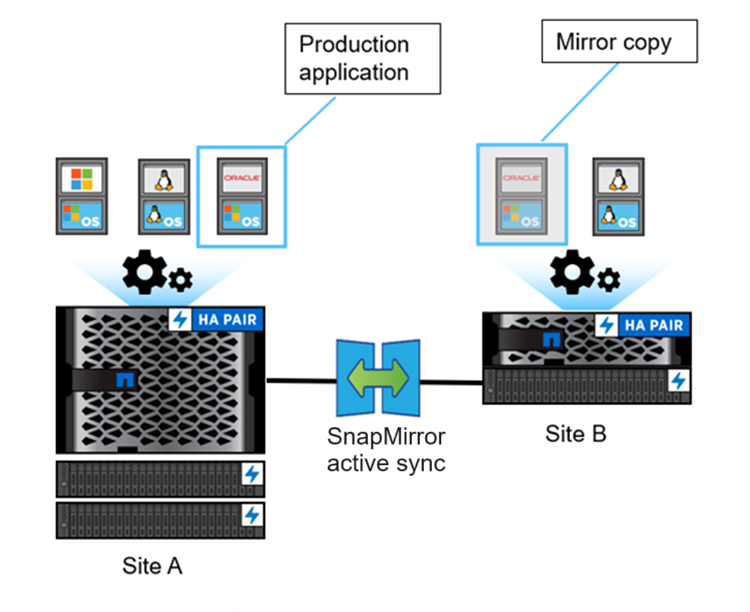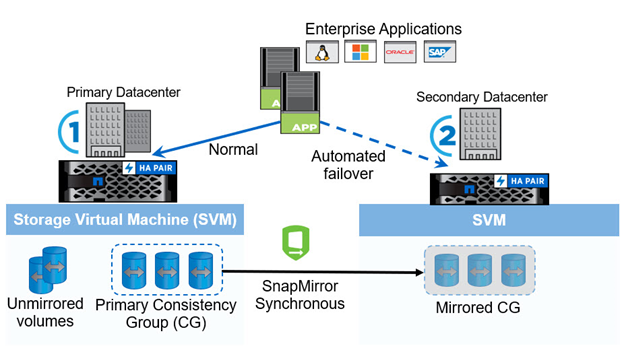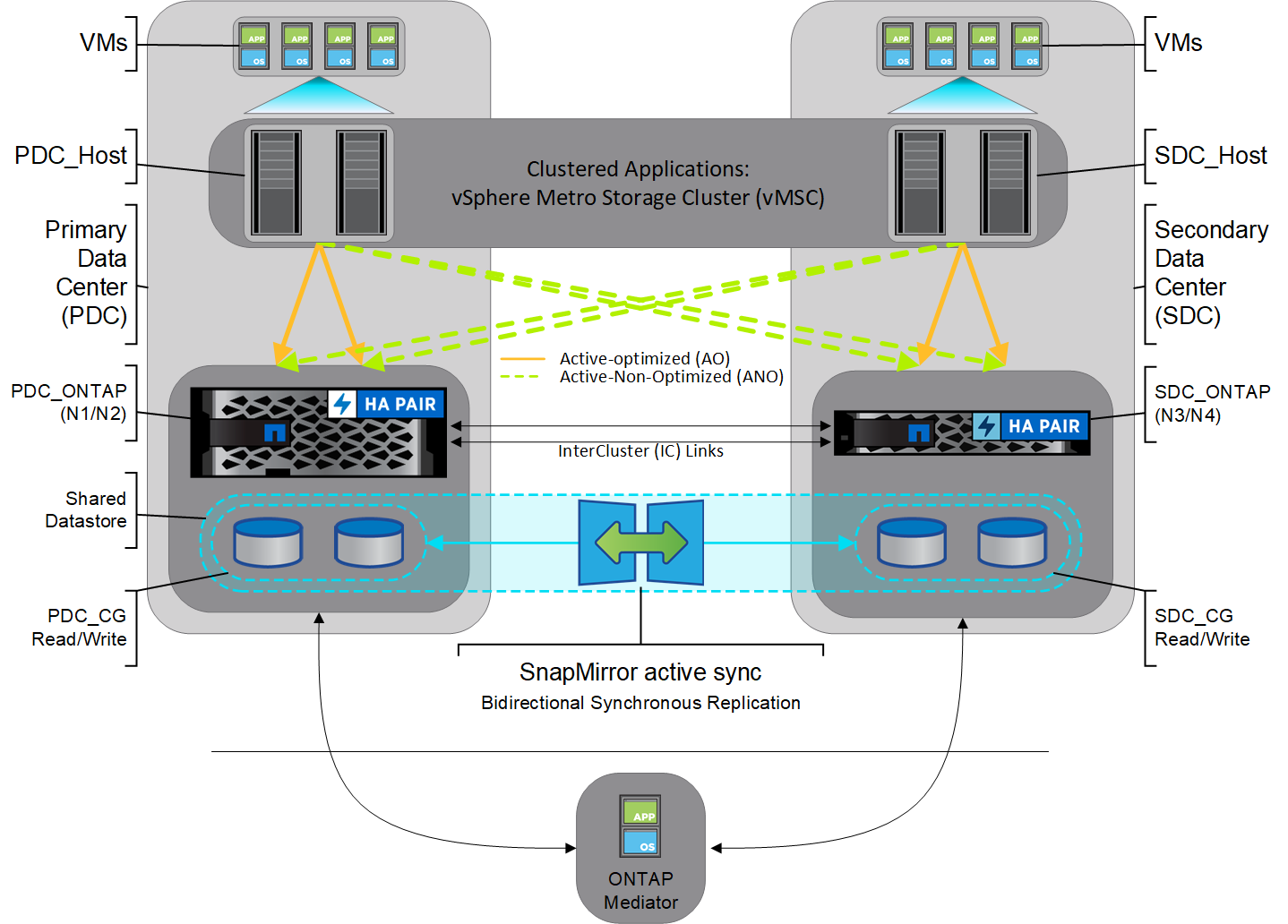ONTAP SnapMirror active sync architecture
 Suggest changes
Suggest changes


The SnapMirror active sync architecture enables active workloads on both clusters, where primary workloads can be served simultaneously from both clusters. Regulations for financial institutions in some countries require businesses to be periodically serviceable from their secondary data centers as well, called "Tick-Tock" deployments, which SnapMirror active sync enables.
The data protection relationship to protect for business continuity is created between the source storage system and destination storage system, by adding the application specific LUNs or NVMe namespaces from different volumes within a storage virtual machine (SVM) to the consistency group. Under normal operations, the enterprise application writes to the primary consistency group, which synchronously replicates this I/O to the mirror consistency group.

Even though two separate copies of the data exist in the data protection relationship, because SnapMirror active sync maintains the same LUN or NVMe namespace identity, the application host sees this as a shared virtual device with multiple paths while only one LUN or NVMe namespace copy is being written to at a time. When a failure renders the primary storage system offline, ONTAP detects this failure and uses the Mediator for re-confirmation; if neither ONTAP nor the Mediator are able to ping the primary site, ONTAP performs the automatic failover operation. This process results in failing over only a specific application without the need for manual intervention or scripting which was previously required for the purpose of failover.
Other points to consider:
-
Unmirrored volumes which exist outside of protection for business continuity are supported.
-
Only one other SnapMirror asynchronous relationship is supported for volumes being protected for business continuity.
-
Cascade topologies are not supported with protection for business continuity.
The role of mediators
SnapMirror active sync uses a mediator to act as a passive witness to SnapMirror active sync copies. In the event of a network partition or unavailability of one copy, SnapMirror active sync uses the mediator to determine which copy continues to serve I/O, while discontinuing I/O on the other copy. In addition to the on-premises ONTAP Mediator, beginning with ONTAP 9.17.1, you can install ONTAP Cloud Mediator to provide the same functionality in a cloud deployment. You can use ONTAP Mediator or ONTAP Cloud Mediator, but you cannot use both at the same time.
The Mediator plays a crucial role in SnapMirror active sync configurations as a passive quorum witness, ensuring quorum maintenance and facilitating data access during failures. It acts as a ping proxy for controllers to determine the liveliness of peer controllers. Although the Mediator does not actively trigger switchover operations, it provides a vital function by allowing the surviving node to check its partner's status during network communication issues. In its role as a quorum witness, the ONTAP Mediator provides an alternate path (effectively serving as a proxy) to the peer cluster.
Furthermore, it allows clusters to get this information as part of the quorum process. It uses the node management LIF and cluster management LIF for communication purposes. It establishes redundant connections through multiple paths to differentiate between site failure and InterSwitch Link (ISL) failure. When a cluster loses connection with the Mediator software and all its nodes due to an event, it is considered not reachable. This triggers an alert and enables automated failover to the mirror consistency group in the secondary site, ensuring uninterrupted I/O for the client. The replication data path relies on a heartbeat mechanism, and if a network glitch or event persists beyond a certain period, it can result in heartbeat failures, causing the relationship to go out-of-sync. However, the presence of redundant paths, such as LIF failover to another port, can sustain the heartbeat and prevent such disruptions.
ONTAP Mediator is installed in a third failure domain, distinct from the two ONTAP clusters it monitors. There are three key components in this setup:
-
Primary ONTAP cluster hosting the SnapMirror active sync primary consistency group
-
Secondary ONTAP cluster hosting the mirror consistency group
-
ONTAP Mediator
ONTAP Mediator is used for the following purposes:
-
Establish a quorum
-
Continuous availability via automatic failover (AUFO)
-
Planned failovers (PFO)

|
ONTAP Mediator 1.7 can manage ten cluster pairs for business continuity. |

|
When the ONTAP Mediator is not available, you cannot perform planned or automated failovers. The application data continues to synchronously replicate without any interruption for zero data loss. |
Beginning with ONTAP 9.17.1, ONTAP Cloud Mediator is available as a cloud-based service in the NetApp Console for use with SnapMirror active sync. Similar to ONTAP Mediator, ONTAP Cloud Mediator provides the following functionality in a SnapMirror active sync relationship:
-
Provides a persistent and fenced store for HA or SnapMirror active sync metadata.
-
Serves as a ping proxy for controller liveliness.
-
Provides synchronous node health query functionality to aid in quorum determination.
The ONTAP Cloud Mediator helps simplify SnapMirror active sync deployment by using the NetApp Console cloud service as a third site that you do not need to manage. The ONTAP Cloud Mediator service provides the same functionality as the on-premises ONTAP Mediator; however, ONTAP Cloud Mediator reduces the operational complexity of maintaining a third site. In contrast, ONTAP Mediator is available as a package and must be installed on a Linux host running at a third site with independent power and network infrastructure for its operations.
SnapMirror active sync operation workflow
The following figure illustrates the design of SnapMirror active sync at a high level.

The diagram shows an enterprise application that is hosted on an storage VM (SVM) at the primary data center. The SVM contains five volumes, three of which are part of a consistency group. The three volumes in the consistency group are mirrored to a secondary data center. In normal circumstances, all write operations are performed to the primary data center; in effect, this data center serves as the source for I/O operations, while the secondary data center serves as a destination.
In the event of a disaster scenario at the primary data center, ONTAP directs the secondary data center to act as the primary, serving all I/O operations. Only the volumes that are mirrored in the consistency group are served. Any operations pertaining to the other two volumes on the SVM is affected by the disaster event.
Symmetric active/active
SnapMirror active sync offers asymmetric and symmetric solutions.
In asymmetric configurations, the primary storage copy exposes an active-optimized path and actively serves client I/O. The secondary site uses a remote path for I/O. The storage paths for the secondary site are considered active-non-optimized. Access to the write LUN is proxied from the secondary site. NVMe protocol is not supported in asymmetric configurations.
In symmetric active/active configurations, active-optimized paths are exposed on both sites, are host specific, and are configurable, meaning hosts on either side are able to access local storage for active I/O. Beginning with ONTAP 9.16.1, symmetric active/active is supported on clusters with up to four nodes. Beginning with ONTAP 9.17.1, symmetric active/active configurations support NVMe protocol on two node clusters.

Symmetric active/active is targeted for clustered applications including VMware Metro Storage Cluster, Oracle RAC, and Windows Failover Clustering with SQL.


